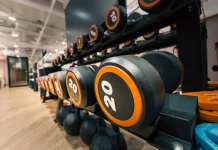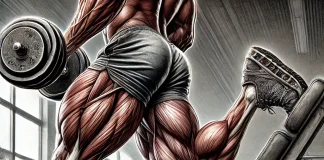Last Updated on September 25, 2014
When it comes to building strong, sculpted arms, the seated bicep curl with dumbbells is a go-to exercise for beginners and seasoned athletes alike. This move isolates the bicep muscles, creating optimal tension and promoting growth. Performing it in a seated position offers added support for the back and helps prevent momentum-based cheating, ensuring your biceps take on the full load. With the right technique, this exercise can become a staple in your arm workout, delivering results that contribute to both aesthetics and strength.
In this article, we’ll dive deep into the seated bicep curl, covering everything you need to know about form, benefits, common mistakes to avoid, variations to keep things fresh, and how to fit this exercise into your overall training plan. Let’s get started on your path to stronger, well-defined arms.
Section 1: The Seated Bicep Curl with Dumbbell – Why It Works
Understanding the Mechanics
The seated bicep curl focuses primarily on the biceps brachii, but it also engages surrounding muscles for stability. Here’s a look at the main muscle groups activated:
- Biceps Brachii: The main target, responsible for flexing the elbow and supinating the forearm.
- Forearm Muscles: These assist in grip and stability.
- Shoulder Muscles: Though minimally involved, they play a role in stabilization.
Benefits of Seated Position
By sitting during this exercise, you remove the temptation to swing your body, forcing the biceps to lift the weight without help from momentum. Additionally, this exercise supports better posture, so you maintain an upright, stable position throughout the movement, which minimizes strain on the lower back.
Section 2: Step-by-Step Guide to the Seated Bicep Curl
- Set Up Your Bench and Dumbbells
- Use a sturdy bench with a short back, if possible, to encourage an upright position without relying on support.
- Choose a weight that challenges you but allows for controlled movement.
- Get into Position
- Sit at the edge of the bench with feet planted firmly on the floor.
- Hold a dumbbell in each hand with your palms facing each other, maintaining a neutral grip to start.
- Engage Your Core
- Sit up straight, tighten your core, and keep your shoulders relaxed.
- This helps prevent leaning or twisting during the lift.
- Start the Curl
- Slowly begin to lift the weights by curling your arms, rotating your wrists so your palms face up as you reach the top.
- Avoid letting your elbows drift away from your sides; keeping them stable ensures maximum bicep engagement.
- Peak Contraction
- Squeeze your biceps hard at the top of the movement.
- This extra squeeze at the peak contraction improves muscle activation.
- Lower with Control
- Slowly lower the dumbbells back to your starting position, resisting gravity as you go down.
Section 3: Pro Tips for Perfect Form
- Avoid Swinging: Keep your movements controlled to avoid letting your shoulders or back help in lifting the weight.
- Breathe Correctly: Inhale as you lower the dumbbells and exhale as you lift.
- Optimal Range of Motion: Don’t cut short at the top or bottom. Go through the full range of motion for maximum muscle engagement.
- Choose the Right Weight: A weight that’s too heavy will compromise form. Aim for a weight that allows you to perform 10–12 reps with good form.
Section 4: Common Mistakes and How to Fix Them
- Using Too Much Weight
- Mistake: Trying to lift a weight that’s too heavy, leading to swinging.
- Solution: Use a moderate weight and prioritize form over load.
- Not Fully Extending or Contracting the Arms
- Mistake: Stopping short of the full range of motion.
- Solution: Lower the weight completely for each rep and fully contract at the top.
- Elbow Positioning
- Mistake: Allowing elbows to move away from the sides.
- Solution: Focus on keeping elbows tight to your torso throughout each curl.
Section 5: Variations to Add Challenge
- Alternating Seated Dumbbell Curl: Curl one arm at a time to improve focus and symmetry.
- Hammer Grip Seated Curl: Keep palms facing each other throughout the movement for a different bicep and forearm activation.
- Incline Seated Curl: Perform the curl on an incline bench to increase the stretch on the biceps.
Section 6: Incorporating Seated Bicep Curls with dumbbell into Your Workout Routine
For best results, integrate seated bicep curls into your arm day or upper body day routine. Aim for:
- 3–4 sets of 10–12 reps if you’re focusing on muscle growth.
- 4–5 sets of 15–20 reps with lighter weights if endurance is your goal.
Section 7: Tracking Your Progress
Keep a journal of your weights, reps, and how each set felt. Over time, try to gradually increase the weight or the reps. This progression is crucial for continuous improvement.
Section 8: Final Tips for Success
- Mind-Muscle Connection: Focus on feeling the biceps work during each rep.
- Proper Warm-Up: Prepare your arms and shoulders with light dynamic stretches or warm-up sets before diving into your working weight.
Conclusion
The seated bicep curl with dumbbell is a classic exercise that’s simple but powerful for building bicep strength and shape. By prioritizing form, choosing the right weight, and following a structured plan, you’ll be on your way to more defined arms and a stronger upper body. Whether you’re just starting your fitness journey or looking to add a new dimension to your arm workouts, mastering this move is a valuable addition to your routine.








